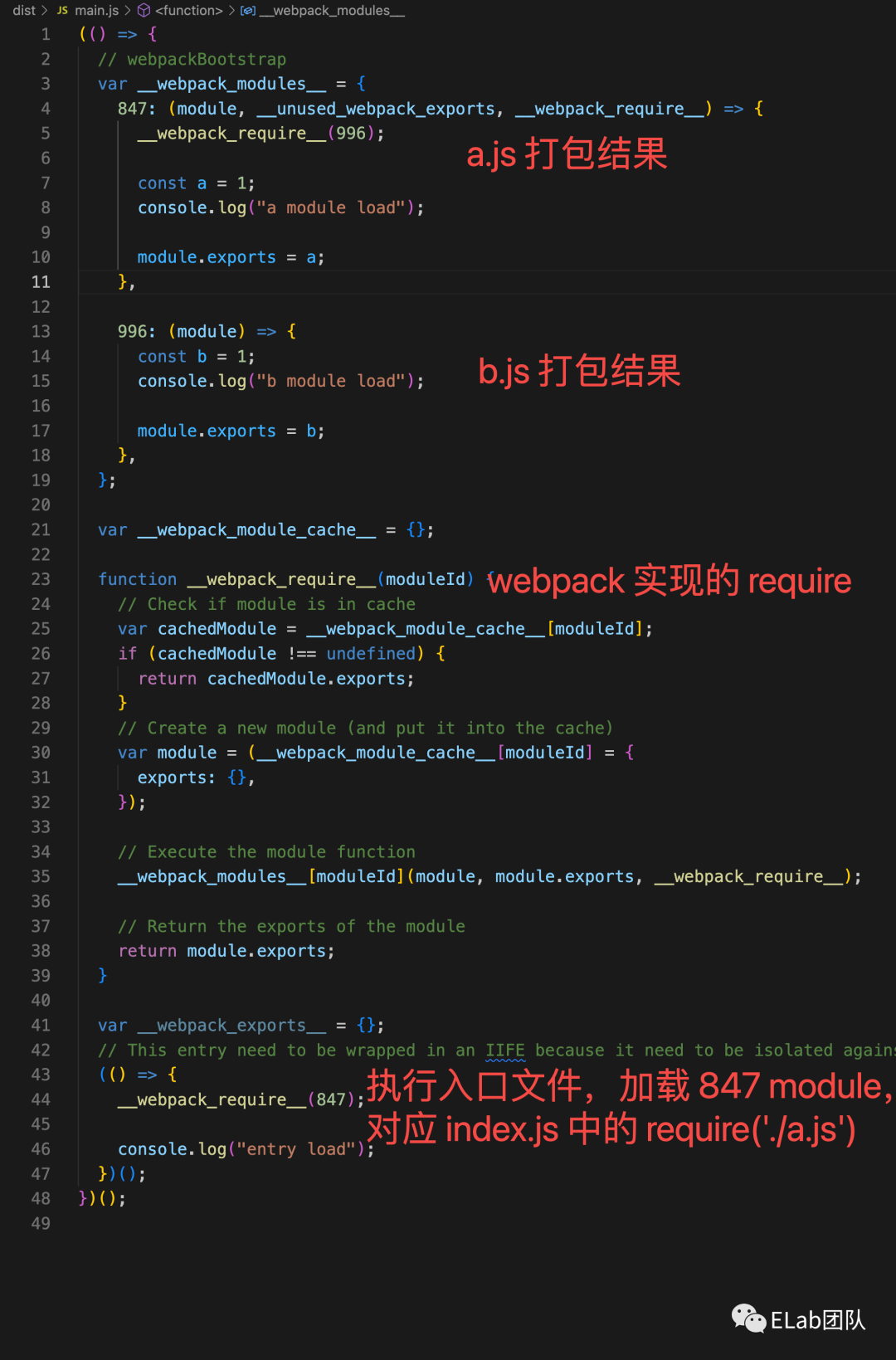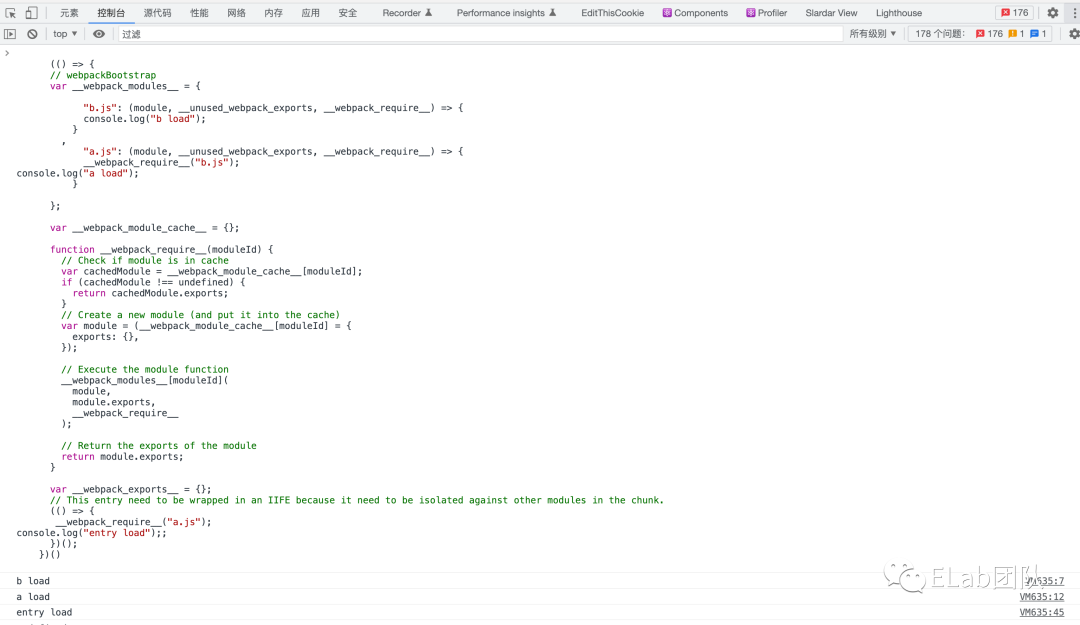从零实现一个迷你 Webpack
webpack 是当前使用较多的一个打包工具,将众多代码组织到一起使得在浏览器下可以正常运行,下面以打包为目的,实现一个简易版 webpack,支持单入口文件的打包,不涉及插件、分包等。
前置知识
举个,先来看看下面这个 demo,例子很简单,一个 index.js,里面引用了一个文件 a.js,a.js 内部引入了 b.js,通过 webpack 最简单的配置,将 index.js 文件作为入口进行打包。
来看看打包后的内容是怎样的
// index.js
require('./a.js');
console.log('entry load');
// a.js
require("./b.js");
const a = 1;
console.log("a load");
module.exports = a;
// b.js
console.log("b load");
const b = 1;
module.exports = b;
在 webpack__require 定义之后,便开始执行入口文件,同时可以看出,webpack 的打包过程便是通过入口文件,将直接依赖和间接依赖以 module 的形式组织到一起,并通过自行实现的 require 实现模块的同步加载。
了解了打包产物后,便可以开始实现简易版的 webpack ,最终打包产物与 webpack 保持一致。
初始化参数
根据 Node 接口 | webpack 中文文档[1] 可以知道,webpack node api 对外暴露出了 webpack 方法,通过调用 webpack 方法传入配置,返回 compiler 对象,compiler 对象包含 run 方法可执行编译,即
const webpack = require('webpack'); // 引用 webpack
const compiler = webpack(options); // 传入配置生成 compiler 对象
compiler.run((err, stats) => { // 执行编译, 传入回调
});因此,首先需要实现一个 webpack 方法,同时该方法支持传入 webpack 配置,返回 compiler 实例,webpack 官方支持了以 cli 的形式运行 webpack 命令和指定参数、配置文件,这一部分暂时简单实现,我们暴露出一个方法,方法接收用户的配置。
// mini-webpack/core/index.js
function webpack() {
// 创建compiler对象
const compiler = new Compiler(options);
}
module.exports = webpack;如上,实现了一个 webpack 方法,可传入一个 options 参数,包括用户指定的打包入口 entry、output 等。
webpack({
entry: './index.js',
output: {
path: path.resolve(__dirname, "dist"),
filename: "[name].js",
},
module: {
rules: []
}
})编译
上面已经实现了 webpack 配置的传入,compiler 的创建,接下来还需要实现 Compiler 类,该类内部暴露一个 run 方法,用于执行编译。
首先需要明确编译过程需要做的事情。
1 . 读取入口文件,将入口文件交给匹配的 loader 处理,返回处理后的代码
2 . 开始编译 loader 处理完的代码
3 . 若代码中依赖了其他文件,则对 require 函数替换为 webpack 自行实现的 __webpack__require__, 保存该文件的处理结果,同时让其他文件回到第 1 步进行处理,不断循环。
4 . 编译结束后,每个文件都有其对应的处理结果,将这些文件的编译结果从初始的入口文件开始组织到一起。
入口文件 loader 处理
读取入口文件,将入口文件交给 匹配的 loader 处理
// mini-webpack compiler.js
const fs = require('fs');
class Compiler {
constructor(options) {
this.options = options || {};
// 保存编译过程编译的 module
this.modules = new Set();
}
run(callback) {
const entryChunk = this.build(path.join(process.cwd(), this.options.entry));
}
build(modulePath) {
let originCode = fs.readFileSync(modulePath);
originCode = this.dealWidthLoader(modulePath, originCode.toString());
return this.dealDependencies(originCode, modulePath);
}
// 将源码交给匹配的 loader 处理
dealWidthLoader(modulePath, originCode) {
[...this.options.module.rules].reverse().forEach(item => {
if (item.test(modulePath)) {
const loaders = [...item.use].reverse();
loaders.forEach(loader => originCode = loader(originCode))
}
})
return originCode
}
}
module.exports = Compiler;入口文件处理
这里需要开始处理入口文件的依赖,将其 require 转换成 自定义的 __webpack_require__,同时将其依赖收集起来,后续需要不断递归处理其直接依赖和间接依赖,这里用到了 babel 进行处理。
// 调用 webpack 处理依赖的代码
dealDependencies(code, modulePath) {
const fullPath = path.relative(process.cwd(), modulePath);
// 创建模块对象
const module = {
id: fullPath,
dependencies: [] // 该模块所依赖模块绝对路径地址
};
// 处理 require 语句,同时记录依赖了哪些文件
const ast = parser.parse(code, {
sourceType: "module",
ast: true,
});
// 深度优先 遍历语法Tree
traverse(ast, {
CallExpression: (nodePath) => {
const node = nodePath.node;
if (node.callee.name === "require") {
// 获得依赖的路径
const requirePath = node.arguments[0].value;
const moduleDirName = path.dirname(modulePath);
const fullPath = path.relative(path.join(moduleDirName, requirePath), requirePath);
// 替换 require 语句为 webpack 自定义的 require 方法
node.callee = t.identifier("__webpack_require__");
// 将依赖的路径修改成以当前路行为基准
node.arguments = [t.stringLiteral(fullPath)];
const exitModule = [...this.modules].find(item => item.id === fullPath)
// 该文件可能已经被处理过,这里判断一下
if (!exitModule) {
// 记录下当前处理的文件所依赖的文件(后续需逐一处理)
module.dependencies.push(fullPath);
}
}
},
});
// 根据新的 ast 生成代码
const { code: compilerCode } = generator(ast);
// 保存处理后的代码
module._source = compilerCode;
// 返回当前模块对象
return module;
}依赖处理
到这里为止便处理完了入口文件,但是在处理文件过程,还收集了入口文件依赖的其他文件未处理,因此,在 dealDependencies 尾部,加入以下代码
// 调用 webpack 处理依赖的代码
dealDependencies(code, modulePath) {
...
...
...
// 为当前模块挂载新的生成的代码
module._source = compilerCode;
// 递归处理其依赖
module.dependencies.forEach((dependency) => {
const depModule = this.build(dependency);
// 同时保存下编译过的依赖
this.modules.add(depModule);
});
...
...
...
// 返回当前模块对象
return module;
}Chunk
在上面的步骤中,已经处理了入口文件、依赖文件,但目前它们还是分散开来,在 webpack 中,是支持多个入口,每个入口是一个 chunk,这个 chunk 将包含入口文件及其依赖的 module
// mini-webpack compiler.js
const fs = require('fs');
class Compiler {
constructor(options) {
this.options = options || {};
// 保存编译过程编译的 module
this.modules = new Set();
}
run(callback) {
const entryModule = this.build(path.join(process.cwd(), this.options.entry));
const entryChunk = this.buildChunk("entry", entryModule);
}
build(modulePath) {
}
// 将源码交给匹配的 loader 处理
dealWidthLoader(modulePath, originCode) {
}
// 调用 webpack 处理依赖的代码
dealDependencies(code, modulePath) {
}
buildChunk(entryName, entryModule) {
return {
name: entryName,
// 入口文件编译结果
entryModule: entryModule,
// 所有直接依赖和间接依赖编译结果
modules: this.modules,
};
}
}
module.exports = Compiler;文件生成
至此我们已经将入口文件和其所依赖的所有文件编译完成,现在需要将编译后的代码生成对应的文件。
根据最上面利用官方 webpack 打包出来的产物,保留其基本结构,将构造的 chunk 内部的 entryModule 的 source 以及 modules 的 souce 替换进去,并根据初始配置的 output 生成对应文件。
// mini-webpack compiler.js
const fs = require('fs');
class Compiler {
constructor(options) {
this.options = options || {};
// 保存编译过程编译的 module,下面会讲解到
this.modules = new Set();
}
run(callback) {
const entryModule = this.build(path.join(process.cwd(), this.options.entry));
const entryChunk = this.buildChunk("entry", entryModule);
this.generateFile(entryChunk);
}
build(modulePath) {
}
// 将源码交给匹配的 loader 处理
dealWidthLoader(modulePath, originCode) {
}
// 调用 webpack 处理依赖的代码
dealDependencies(code, modulePath) {
}
buildChunk(entryName, entryModule) {
}
generateFile(entryChunk) {
// 获取打包后的代码
const code = this.getCode(entryChunk);
if (!fs.existsSync(this.options.output.path)) {
fs.mkdirSync(this.options.output.path);
}
// 写入文件
fs.writeFileSync(
path.join(
this.options.output.path,
this.options.output.filename.replace("[name]", entryChunk.name)
),
code
);
}
getCode(entryChunk) {
return `
(() => {
// webpackBootstrap
var __webpack_modules__ = {
${entryChunk.modules.map(module => `
"${module.id}": (module, __unused_webpack_exports, __webpack_require__) => {
${module._source}
}
`).join(',')}
};
var __webpack_module_cache__ = {};
function __webpack_require__(moduleId) {
// Check if module is in cache
var cachedModule = __webpack_module_cache__[moduleId];
if (cachedModule !== undefined) {
return cachedModule.exports;
}
// Create a new module (and put it into the cache)
var module = (__webpack_module_cache__[moduleId] = {
exports: {},
});
// Execute the module function
__webpack_modules__[moduleId](
module,
module.exports,
__webpack_require__
);
// Return the exports of the module
return module.exports;
}
var __webpack_exports__ = {};
// This entry need to be wrapped in an IIFE because it need to be isolated against other modules in the chunk.
(() => {
${entryChunk.entryModule._source};
})();
})()
`;
}
}
module.exports = Compiler;试试在浏览器下跑一下生成的代码
